Welcoming a dog into your home brings immense joy, but for individuals with pet allergies, this dream can often be clouded by sneezing, itching, and wheezing. The good news is that living with a furry friend doesn’t have to be a constant battle against allergens. Many dog breeds are known for their low-shedding coats, which can significantly reduce the amount of dander—a common allergen—they release into the environment. When you’re seeking an allergy-friendly companion, selecting a dog that doesn’t shed much is a crucial first step.
For many families, a medium-sized dog strikes the perfect balance: not too small to be fragile, and not too large to overwhelm smaller living spaces or require excessive outdoor area. They offer a comfortable presence, often adapting well to various lifestyles, from active families to more relaxed households. This guide focuses specifically on medium size dog breeds that don’t shed, helping you find a canine companion that fits both your lifestyle and your allergic needs. We’ll explore what makes a dog truly “hypoallergenic” and introduce you to some of the best medium-sized, low-shedding breeds that could be your next beloved family member.
Understanding “Non-Shedding” and Hypoallergenic Dogs
The term “hypoallergenic” is often used to describe dogs that produce fewer allergens, making them a better fit for people with sensitivities. However, it’s essential to understand that no dog is 100% allergen-free. All dogs produce allergens, primarily through dander (dead skin cells), saliva, and urine. Dogs labeled “hypoallergenic” typically have coats that shed very little or have hair-like coats that trap dander, rather than releasing it into the air. This reduced shedding significantly minimizes the distribution of allergens in the home.
For those prone to allergies, the amount of dander, saliva, and urine a dog produces, and how easily these particles are dispersed, dictates the severity of an allergic reaction. Dogs that don’t shed much effectively contain these allergens within their coats, requiring regular grooming to remove them. Therefore, while a non-shedding dog won’t eliminate all allergens, they are a practical and often successful choice for allergy sufferers seeking a canine companion.
Choosing a medium-sized dog that doesn’t shed offers several advantages. These dogs are generally more manageable in terms of exercise needs compared to larger breeds, yet sturdy enough for playful interactions with children. Their size often makes them suitable for apartment living or homes with smaller yards, provided their exercise requirements are met. Furthermore, their low-shedding coats mean less fur around the house, making daily cleaning routines easier for allergy management. If you’re considering an allergy-friendly companion, finding the best dog to have that doesn’t shed is a great starting point for your research.
Top Medium Size Dog Breeds That Don’t Shed
If you’re looking for a delightful companion that’s also allergy-friendly, these medium-sized breeds offer a fantastic blend of personality, manageable size, and low-shedding coats.
1. Standard Poodle
The Standard Poodle, the largest of the three Poodle varieties, is a highly intelligent and elegant dog known for its curly, dense coat that sheds minimally. Originally bred for hunting, these dogs are active and require regular exercise and mental stimulation. Their non-shedding coat needs consistent grooming, including brushing several times a week and professional clipping every 4-6 weeks, to prevent matting and keep it healthy. Standard Poodles are generally good-natured, adaptable, and make excellent family pets, thriving on human companionship and training. They typically weigh between 40-70 pounds and stand over 15 inches tall, fitting perfectly into the medium-to-large category.
 White Standard Poodle trotting through green grass
White Standard Poodle trotting through green grass
2. Standard Schnauzer
The Standard Schnauzer is a robust, intelligent, and versatile medium-sized dog, weighing between 30-50 pounds and standing 17-20 inches tall. Known for their distinctive wiry coat, bushy eyebrows, and beard, Standard Schnauzers shed very little. Their coat requires regular brushing and hand-stripping or professional grooming to maintain its texture and prevent matting. These dogs are energetic and require at least an hour of exercise daily, combined with mental challenges, to keep them happy and well-behaved. They are loyal, protective, and can be excellent family dogs with proper socialization and training.
 Gray Standard Schnauzer standing alert in a grassy field
Gray Standard Schnauzer standing alert in a grassy field
3. Portuguese Water Dog
Once a helper to fishermen in Portugal, the Portuguese Water Dog is a spirited and intelligent medium-sized breed that weighs 35-60 pounds and stands 17-23 inches tall. Their thick, curly, waterproof coat is low-shedding, making them a popular choice for allergy sufferers. This coat requires frequent brushing and regular trims to prevent matting. As their name suggests, they love water and are highly energetic, needing ample daily exercise that includes swimming, fetching, and engaging activities. Portuguese Water Dogs are highly trainable, loyal, and thrive as part of an active family.
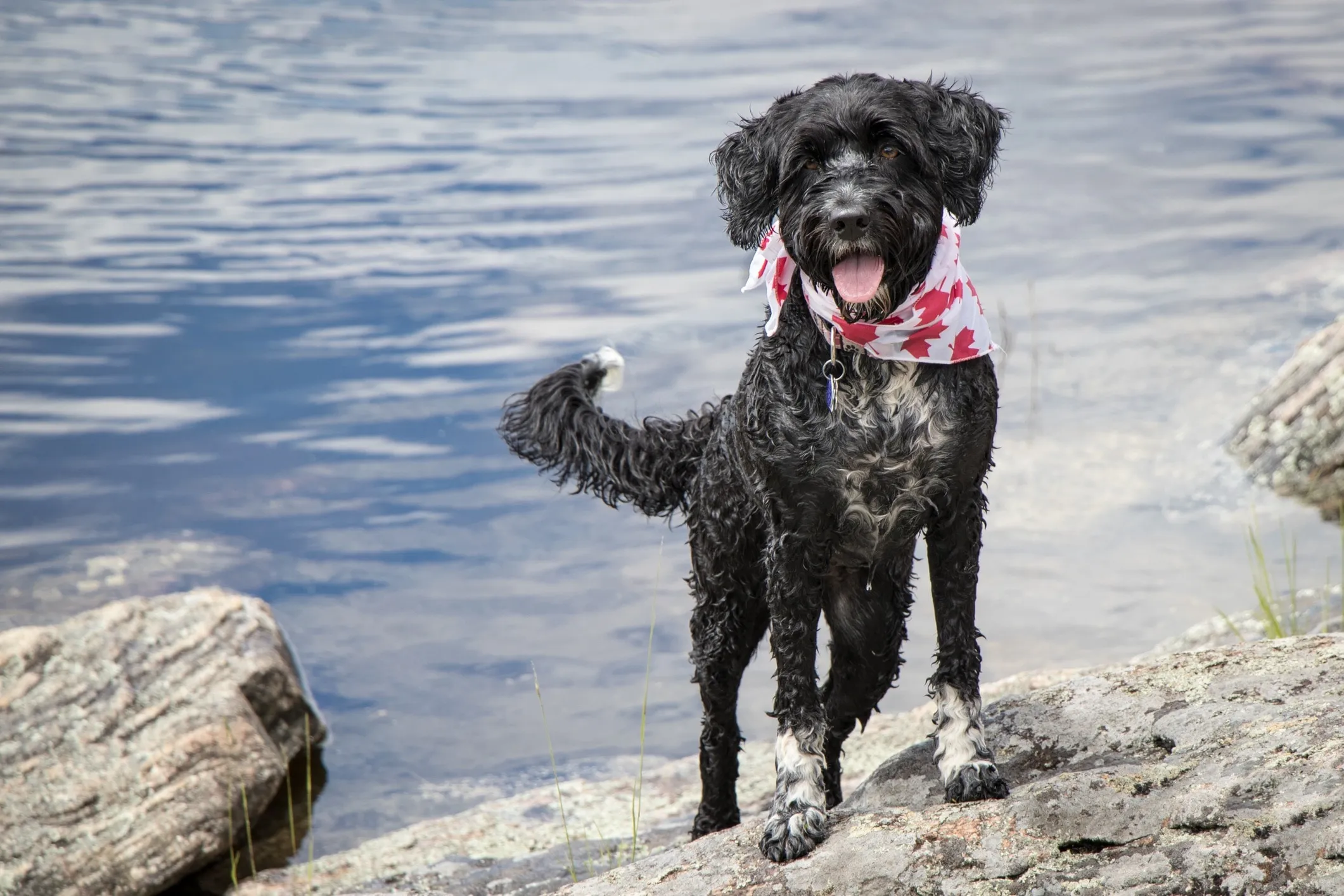 Black and white Portuguese Water Dog wearing a red bandana by the water's edge
Black and white Portuguese Water Dog wearing a red bandana by the water's edge
4. Labradoodle
A popular crossbreed between a Labrador Retriever and a Poodle, Labradoodles come in various sizes, with medium variants weighing 30-65 pounds. Their coats can range from wavy to curly, and many inherit the Poodle’s low-shedding qualities, though consistency can vary. Medium Labradoodles are known for their friendly, intelligent, and eager-to-please nature, making them excellent family pets. They are generally good with children and other animals when well-socialized. These active dogs require regular exercise and mental stimulation to prevent boredom. Their grooming needs depend on their coat type, but regular brushing is always necessary to keep matting at bay.
 Brown Standard Labradoodle enjoying a walk in a park
Brown Standard Labradoodle enjoying a walk in a park
5. Goldendoodle
Another beloved Poodle mix, the Goldendoodle is a cross between a Golden Retriever and a Poodle. Medium Goldendoodles typically weigh 30-60 pounds and, like Labradoodles, often boast low-shedding coats with wavy or curly textures. Their friendly and outgoing personalities, combined with high intelligence, make them adaptable and easy to train. Goldendoodles are social dogs who thrive on being part of the family and require consistent exercise. Regular grooming, including brushing and occasional professional trims, is crucial to prevent their soft coats from matting.
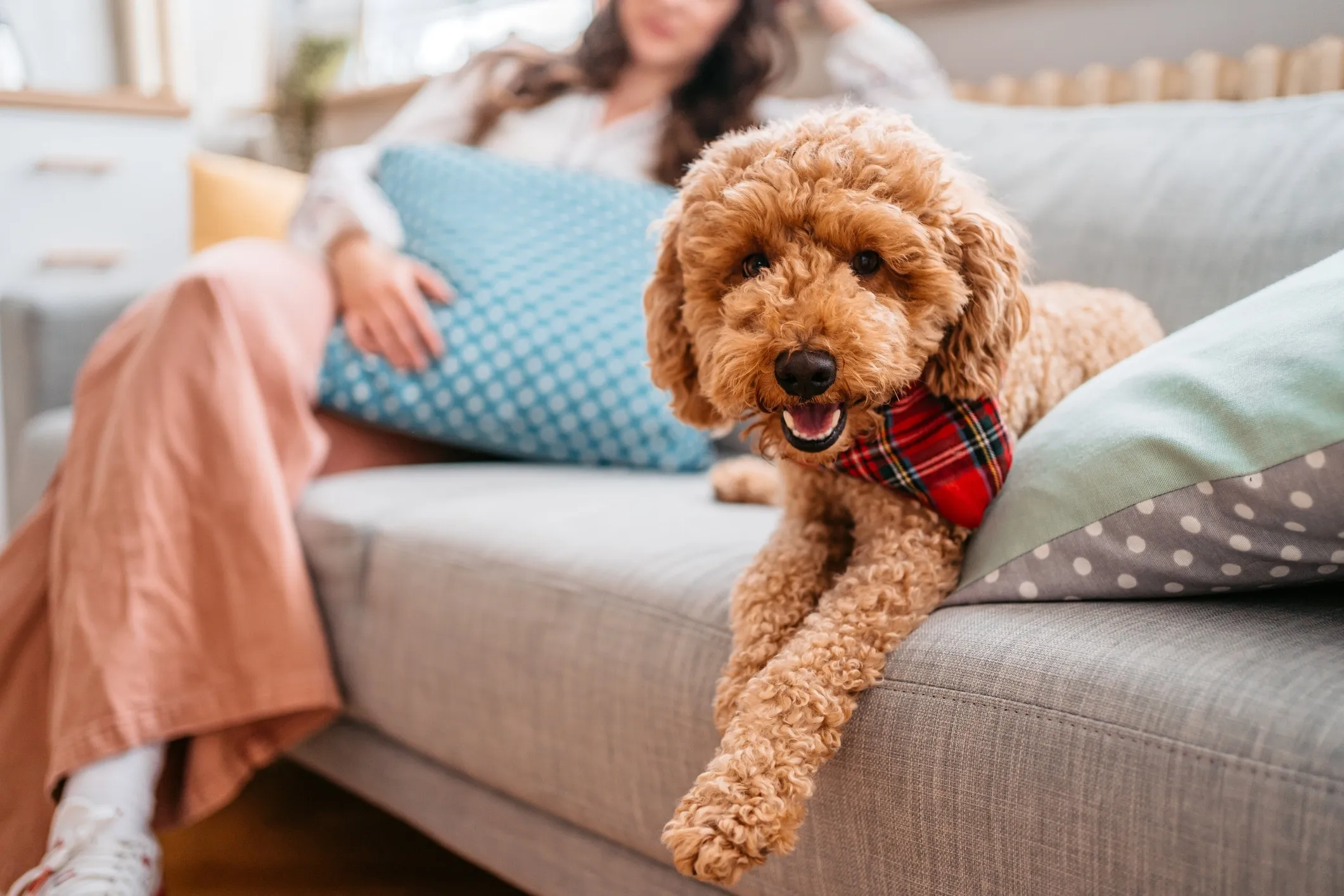 Goldendoodle relaxing on a couch, a person in the background
Goldendoodle relaxing on a couch, a person in the background
6. Lagotto Romagnolo
The Lagotto Romagnolo is an ancient Italian breed originally used for truffle hunting. These charming medium-sized dogs weigh 24-35 pounds and stand 16-19 inches tall. Their unique woolly, curly coat is double-layered and virtually non-shedding, providing excellent protection from cold water. This coat needs regular maintenance, including brushing and periodic clipping (every 2-3 months), to prevent felting. Lagotti Romagnoli are intelligent, eager to please, and energetic, requiring daily mental and physical challenges. They are generally good-natured, making them suitable companions for active families with children and other pets.
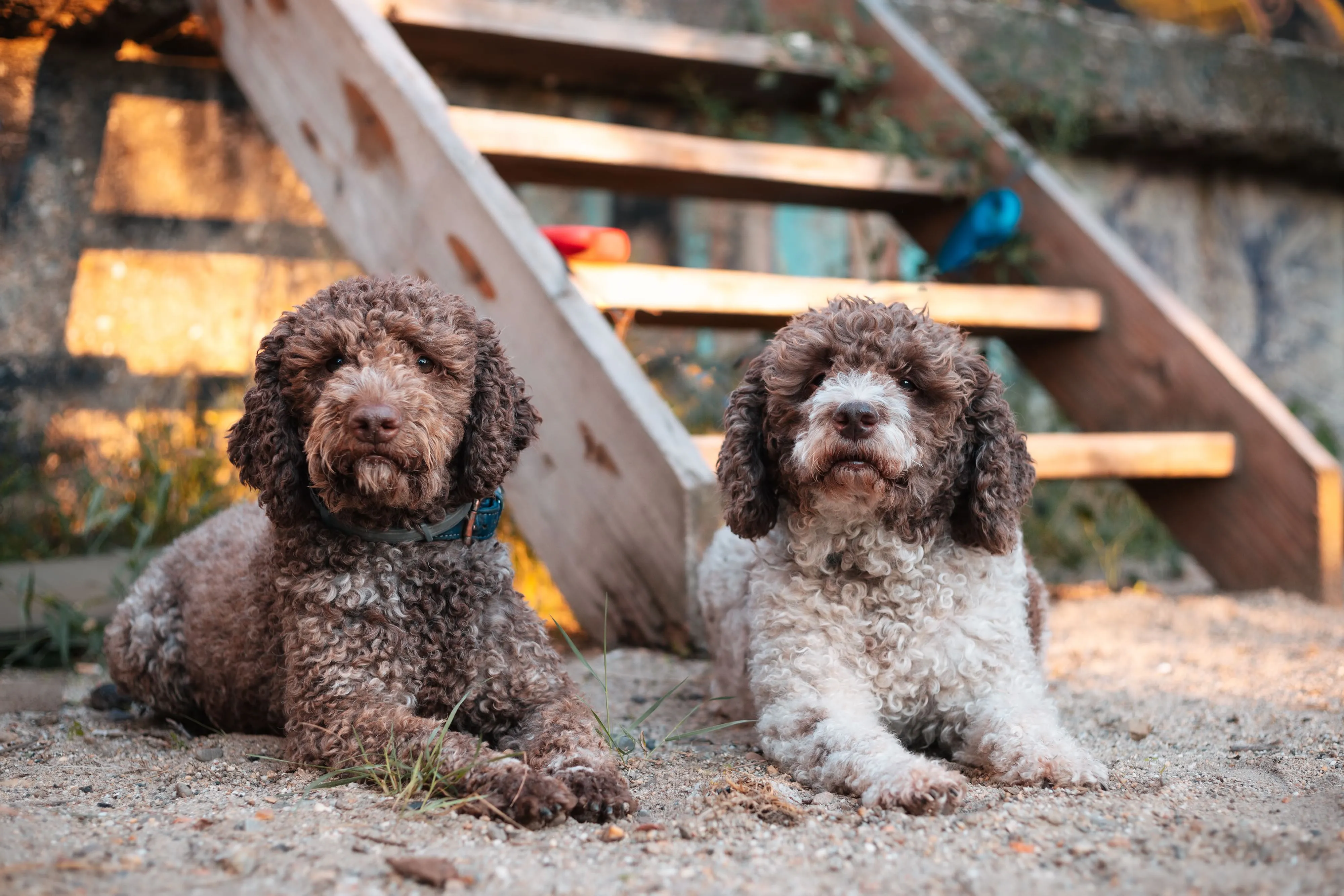 Two Lagotto Romagnolo dogs with curly, woolly coats lying in the dirt
Two Lagotto Romagnolo dogs with curly, woolly coats lying in the dirt
7. Irish Water Spaniel
A distinctive and elegant breed, the Irish Water Spaniel is a sturdy, high-energy water retriever that falls into the medium-to-large size range, typically weighing 45-68 pounds and standing 21-24 inches tall. They possess a dense, waterproof, curly coat that sheds minimally and is always liver (brown) in color. This unique coat requires regular brushing and occasional trimming to prevent matting. Irish Water Spaniels are known for their playful, intelligent, and highly trainable nature. They have a high exercise drive and need consistent physical activity, such as swimming, fetching, and long walks, to stay happy and healthy.
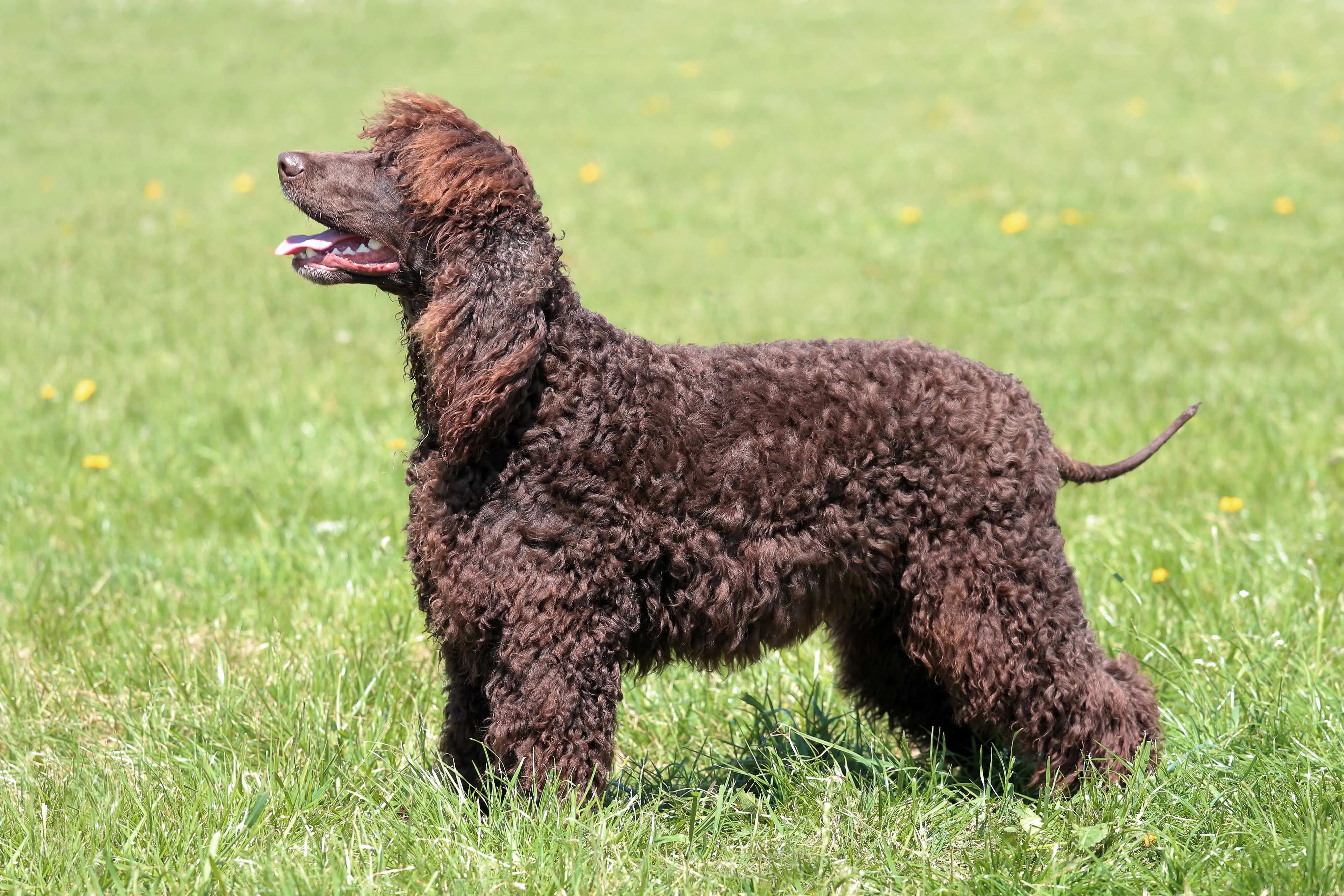 Profile of a brown Irish Water Spaniel with a curly coat
Profile of a brown Irish Water Spaniel with a curly coat
8. Aussiedoodle
A cross between an Australian Shepherd and a Poodle, Aussiedoodles are known for their intelligence and high energy. Medium-sized Aussiedoodles typically range from 25-50 pounds. Their coats can vary but often feature low-shedding wavy or curly textures. These dogs inherit the smarts and active nature from both parent breeds, meaning they require substantial daily exercise and mental stimulation to prevent destructive behaviors due to boredom. Aussiedoodles are affectionate and eager to please, making them wonderful family companions for those who can meet their high activity needs. Their coats require regular brushing to keep them free of mats.
 Standard Aussiedoodle dog standing proudly on a sandy beach
Standard Aussiedoodle dog standing proudly on a sandy beach
9. Soft Coated Wheaten Terrier
The Soft Coated Wheaten Terrier is a charming and spirited medium-sized Irish breed, weighing 30-40 pounds and standing 17-19 inches tall. True to their name, they have a silky, soft, wavy coat that feels incredibly smooth and sheds very little. However, this coat requires daily brushing to prevent matting. Wheatens maintain a high energy level throughout their lives and need ample exercise and playful interaction to keep them well-behaved and happy. They are known for their friendly, joyful demeanor and make affectionate, loyal family members.
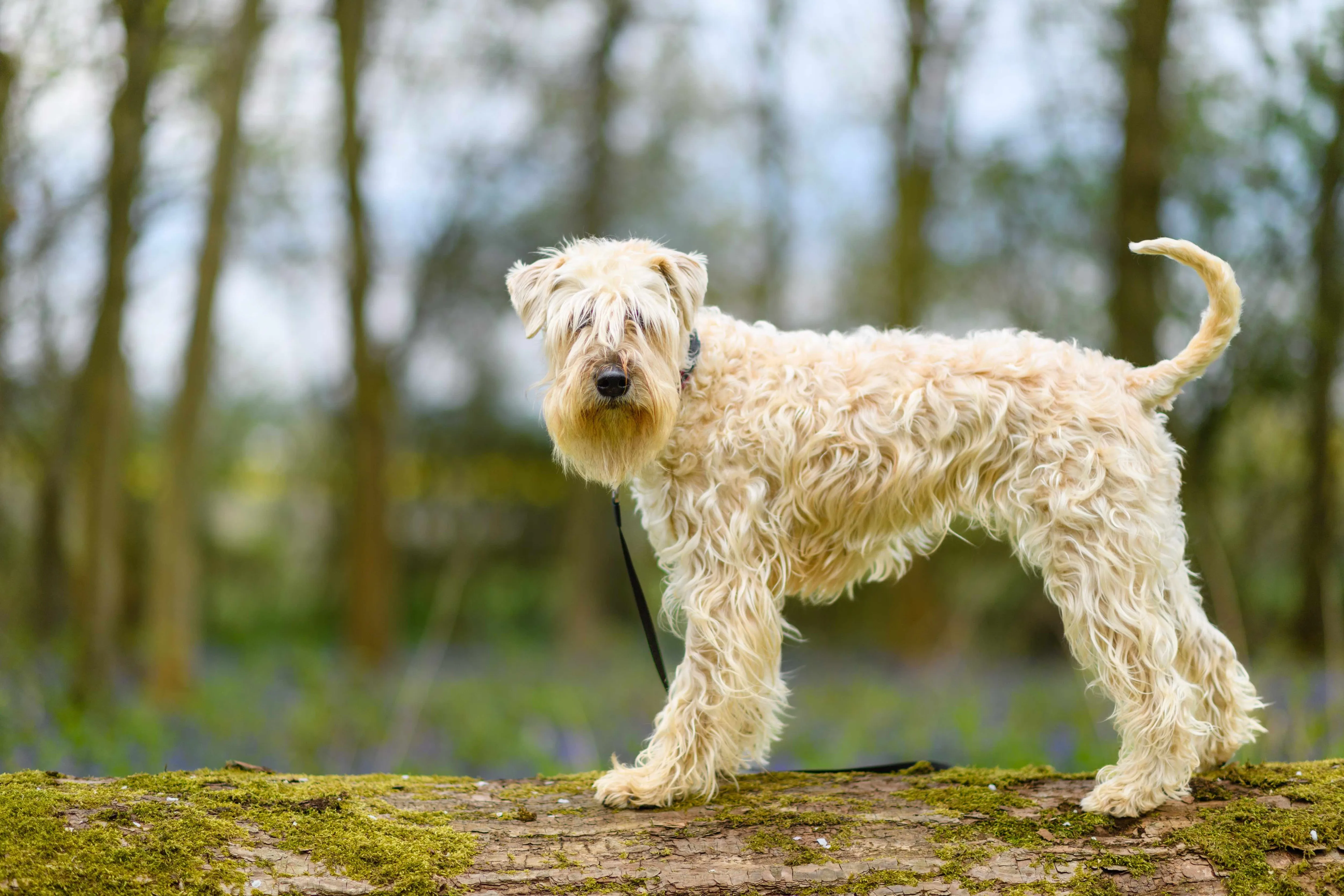 Soft Coated Wheaten Terrier dog posing on a weathered log
Soft Coated Wheaten Terrier dog posing on a weathered log
10. Schnoodle
A delightful blend of a Schnauzer and a Poodle, the Schnoodle is a versatile dog that can range in size from toy to standard. Medium Schnoodles typically weigh between 20-45 pounds. Their coats are generally low-shedding and can be curly or wavy, depending on which parent’s genetics are more dominant. Schnoodles are intelligent, playful, and affectionate, making them excellent companions for a variety of households. They thrive on interaction and require moderate exercise and consistent training. Regular grooming is essential for their coats to prevent tangles and mats.
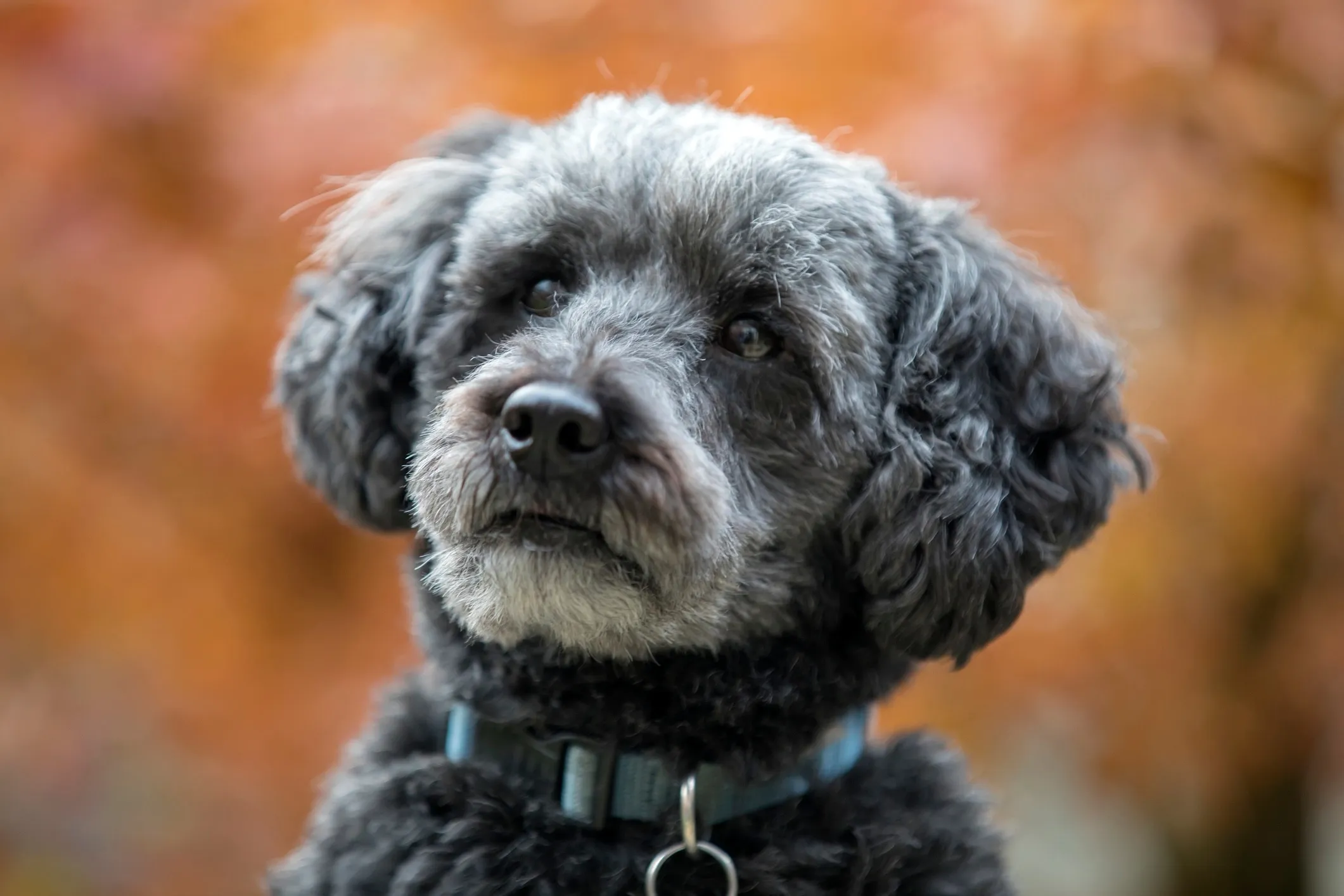 Close-up portrait of a gray Schnoodle dog
Close-up portrait of a gray Schnoodle dog
11. Bedlington Terrier
Often described as a “lamb in dog’s clothing,” the Bedlington Terrier is a distinctive medium-sized dog, weighing 17-23 pounds and standing 15-17.5 inches tall. They possess a unique curly, woolly coat that is low-shedding. Their coat requires regular brushing and scissoring to maintain its signature look, including their distinctive topknot and pom-pom ear tufts. Bedlington Terriers are charming, intelligent, and loyal companions, known for their affectionate nature. They are active dogs that need daily exercise and thrive on being close to their people, often developing separation anxiety if left alone for extended periods.
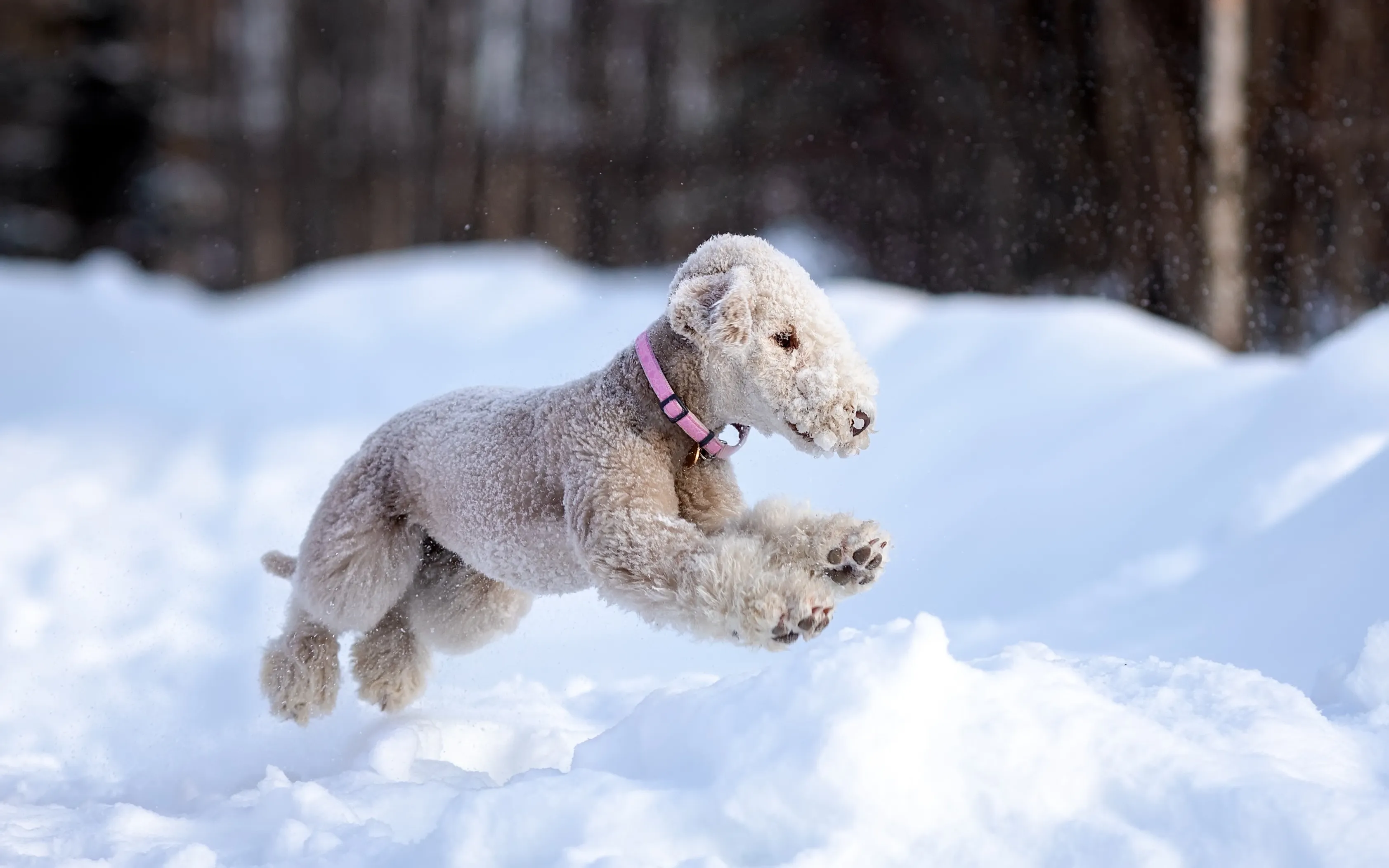 White Bedlington Terrier gracefully running through light snow
White Bedlington Terrier gracefully running through light snow
12. Xoloitzcuintli (Standard)
The Xoloitzcuintli, also known as the Mexican Hairless Dog, is an ancient and unique breed. The standard size Xoloitzcuintli fits into the medium category, weighing 30-55 pounds and standing 18-23 inches tall. They come in two varieties: hairless (with minimal hair on the head, paws, and tail) and coated (with a short, smooth coat). Both varieties are considered hypoallergenic. Xolos are intelligent, calm, and devoted to their families. They require moderate exercise and, for the hairless variety, special skin care to protect them from sunburn and dryness. If you’re looking for athletic dog breeds that don’t shed, the Xoloitzcuintli’s agility might surprise you.
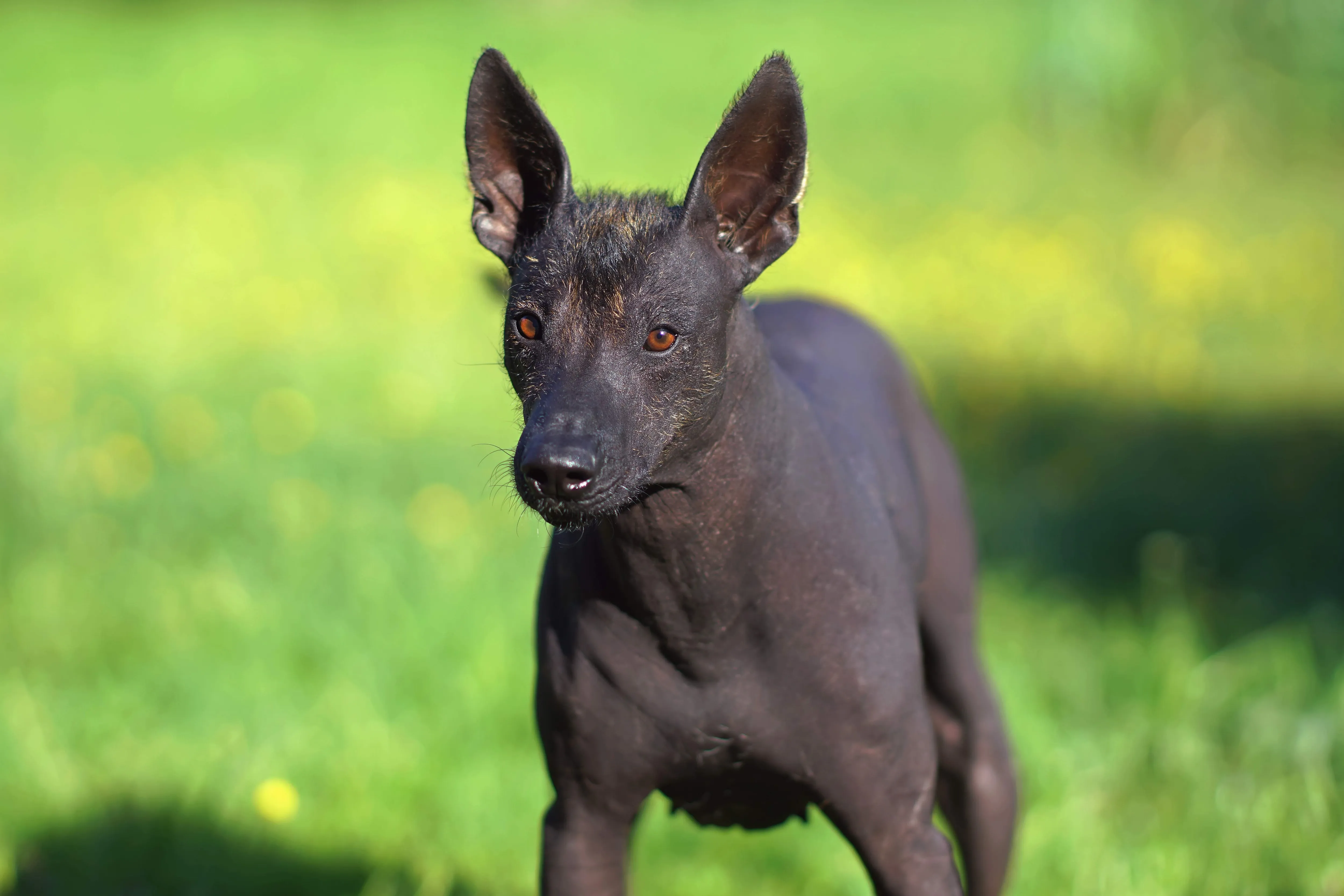 Black Mexican Hairless Dog (Xoloitzcuintli) standing gracefully in green grass
Black Mexican Hairless Dog (Xoloitzcuintli) standing gracefully in green grass
13. Whoodle
The Whoodle is a hybrid cross between a Soft Coated Wheaten Terrier and a Poodle. This delightful mix typically results in a medium-sized dog weighing 20-50 pounds with a low-shedding, soft, wavy, or curly coat. Whoodles inherit the intelligence, friendliness, and affectionate nature from both parent breeds, making them wonderful family companions. They are active dogs that require regular exercise and mental stimulation to keep them happy and well-adjusted. Consistent grooming, including daily brushing, is essential to maintain their beautiful coats and prevent matting.
 Tan Whoodle puppy playfully pulling on a washcloth
Tan Whoodle puppy playfully pulling on a washcloth
14. Bernedoodle (Medium-sized varieties)
A Bernedoodle is a cross between a Bernese Mountain Dog and a Poodle. While they can be large, medium-sized Bernedoodles typically weigh 40-70 pounds. They often inherit the Poodle’s low-shedding coat, which can be wavy or curly. Bernedoodles are known for their friendly, affectionate, and gentle demeanor, making them a popular choice for families with children and other pets. They combine the loyal, calm nature of the Bernese with the intelligence and playfulness of the Poodle. These active dogs need plenty of exercise to stay happy and healthy, and their coats require regular grooming to prevent tangles and mats.
 Large Bernedoodle dog with black, white, and brown fur lying in green grass with its tongue out
Large Bernedoodle dog with black, white, and brown fur lying in green grass with its tongue out
15. Barbet
The Barbet is a cheerful, shaggy, and woolly-coated dog originating from France, where its name means “beard.” This medium-to-large breed typically weighs 35-65 pounds and stands 20-25 inches tall. Their thick, curly, woolly coat is low-shedding and protects them in cold water, as they were originally bred as water dogs. The Barbet’s coat requires extensive grooming, including brushing two to three times a week and regular professional trimming to prevent matting. Barbets are intelligent, friendly, and highly adaptable dogs that thrive on companionship and enjoy active lifestyles, particularly swimming.
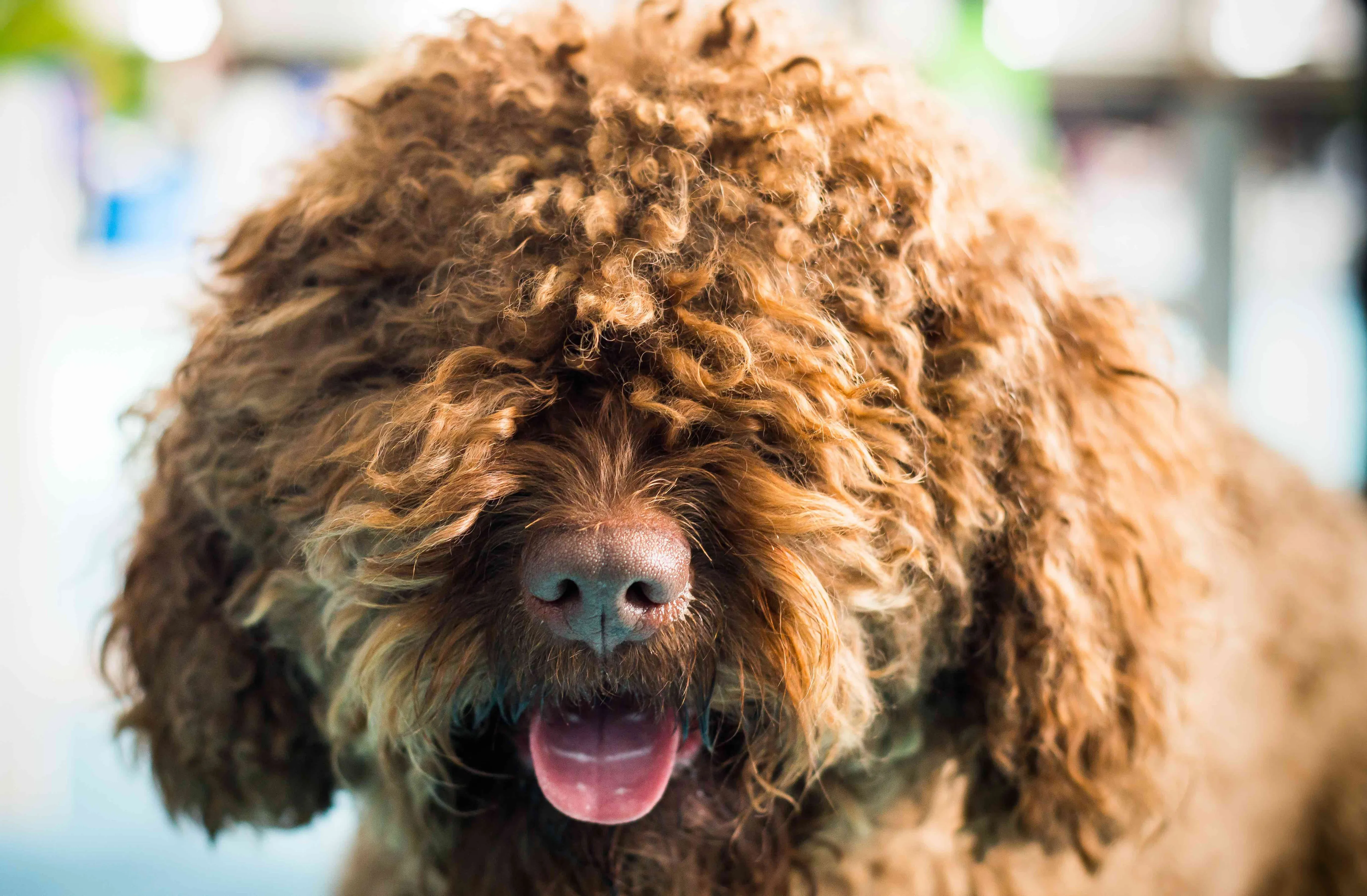 Close-up of a curly red Barbet dog's face with a characteristic beard
Close-up of a curly red Barbet dog's face with a characteristic beard
16. Peruvian Inca Orchid (Medium)
The Peruvian Inca Orchid is a rare and ancient breed that comes in three sizes: small, medium, and large. The medium size typically weighs between 26-31 pounds and stands 15.75-19.75 inches tall. These elegant dogs are hypoallergenic, primarily due to their nearly hairless bodies, though a coated variety with a short, smooth single coat also exists. Both types are low-shedding. Peruvian Inca Orchids are affectionate, alert, and can be reserved with strangers, requiring early socialization. Their unique appearance and gentle nature make them captivating companions, but the hairless variety needs protection from sun and cold.
 Peruvian Inca Orchid dog, mostly hairless with tufts on head and feet, standing outdoors
Peruvian Inca Orchid dog, mostly hairless with tufts on head and feet, standing outdoors
For those specifically seeking a smaller low-shedding companion, exploring dogs that don’t shed and are small can offer more tailored options.
Living Successfully with a Medium Non-Shedding Dog
Bringing a medium-sized, non-shedding dog into your home is a wonderful step towards an allergy-friendly life, but it also comes with specific responsibilities to ensure both your well-being and your dog’s health.
Consistent Grooming for Healthy Coats
While “non-shedding” is a huge advantage for allergy sufferers, it doesn’t mean “no maintenance.” In fact, these coats often require more consistent grooming than shedding breeds. Their hair continues to grow and, if not regularly brushed, can easily mat, trapping dander and becoming uncomfortable for the dog.
- Regular Brushing: Most low-shedding breeds need brushing several times a week, some even daily. This removes loose hair, dander, and prevents tangles.
- Professional Grooming/Trimming: Many non-shedding coats require regular professional grooming (every 4-8 weeks) for trimming, bathing, and de-matting. Learning to groom your dog at home can also be a cost-effective solution.
- Bathing: Bathe your dog every 4-6 weeks using a gentle dog shampoo. Some specialized shampoos can help reduce dander, though regular bathing itself helps wash away allergens.
Maintaining an Allergen-Reduced Home
Even with a low-shedding dog, maintaining a clean environment is paramount for allergy management.
- Vacuum Regularly: Use a vacuum cleaner with a HEPA filter on carpets, rugs, and upholstery to pick up stray dander.
- Dust Frequently: Dust surfaces with a damp cloth to capture airborne allergens.
- Wash Bedding: Regularly wash your dog’s bedding and your own bedding in hot water.
- Air Purification and Ventilation: Consider using HEPA air purifiers in main living areas and bedrooms. Keep your home well-ventilated by opening windows when the weather permits.
- Designated Dog-Free Zones: If allergies are severe, consider keeping your bedroom a dog-free zone to provide an allergen-reduced sanctuary.
Consulting Your Healthcare Professional
Managing pet allergies is a personal journey, and consulting with your healthcare provider is always the best approach. They can offer guidance on:
- Allergy Testing: Confirming your specific allergens can help you make informed decisions.
- Medication and Treatments: Your doctor can recommend antihistamines, nasal sprays, or immunotherapy (allergy shots) to help manage symptoms.
- Personalized Advice: They can provide tailored advice based on the severity of your allergies and your living situation.
Bringing a medium-sized, non-shedding dog into your life can truly enhance your quality of life, allowing you to experience the unparalleled joy of pet companionship without constant allergic reactions. These breeds offer a balanced combination of size, temperament, and low-allergen qualities, making them ideal family additions. For families looking for a compatible companion, many of these dogs also make dogs that don’t shed and are good family dogs. With proper care, grooming, and household management, an allergy-friendly medium dog can become a cherished member of your family for years to come.
WRITTEN BY
Nicole Zittritsch, LVT, BSc, MPH
Veterinarian Technician
